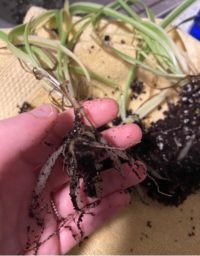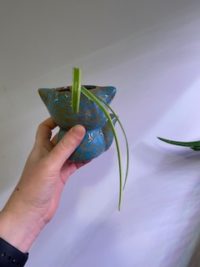Hello, my name is Ms. Kate and welcome to my series called, “Gardening with Ms. Kate!”
This series is about teaching us how to keep our plants (indoor and outdoor) happy and healthy. Today, we will be talking about plants being rootbound; what it means, what it can do, and how to solve it.
Rootbound is when the roots of a plant wind around each other, causing them to bind. This can cause the plant itself to suffer; when its roots are bound like this, they are unable to get enough nutrients or water. You can identify if your plant is rootbound when it does not respond to water. To confirm our diagnosis, we will carefully take our plant out of its pot by flipping the pot upside down (into a trash can or sink for the soil that is about to spill out) with our hands holding onto the plant, we will carefully pry it out of the soil. If the roots are wrapped around the whole plant, it is indeed rootbound.
Now that we have effectively identified that the plant is rootbound, how do we solve this issue? You can fix the problem in two ways; repotting the plant in a larger plant to let the roots expand or, unwind the roots, kind of like a necklace that has a lot of knots in it. Depending on how twisted the roots are, you may need to prune them.
The first picture shows my spider plant Arachnae. She is actually four cuttings in one pot, which is pretty rootbound to my dismay. To try to remedy the issue, I first tried to transfer her into a larger pot, in the hopes the extra space would help her roots relax and grow away from each other. Arachnae still did not react to being watered and was wilting even more. So, I had to try another way to help her out!

I took Arachnae out of her pot very carefully (my hands covered the topsoil, kept the plants in place, and in the sink). I broke apart the soil around the roots until I was able to get the plant on a towel. As you can see, the smaller pieces are linked into the middle section. How in the world are we going to get these roots apart? It’s like a game of twister, but with more fragile limbs!
To detangle your plant, take a hold of a section of plant, and gently wiggle it out of the bundle of roots. You may need to help extract the plant if they are twisted too much, but after a little work, you will have this picture:

Now the main pieces of the spider plant are separated! Now what, Ms. Kate? Now, we repot our pieces! Place them in new soil and their sunny spot (depending on the plant type) and water it as required. Below is one of the repotted pieces of Arcahnae!

This was my first time having to do some surgery on a plant. Even though it had its difficulties, I am happy to learn something new that can benefit plants in the future. Gardening is full of challenges and even a little frustration, but the most rewarding part of gardening is seeing how plants react to you taking care of them.
Good luck, be patient, and happy gardening!





